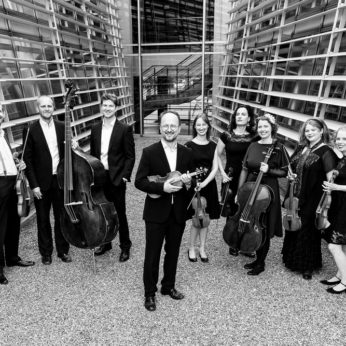Composer: Arcangelo Corelli (b. 1653 - d. 1713)
Performance date: 06/07/2019
Venue: St. Brendan’s Church
Composition Year: 1653 - 1713
Duration: 00:07:18
Recording Engineer: Ciaran Cullen, RTÉ
Instrumentation Category:Baroque Ensemble
Instrumentation Other: 3vn, va, vc, db, lute, hpd, ob
Artists:
Camerata Øresund (Ida Lorenzen [violin], Tinne Albrechtsen [violin], Alison Luthmers [vioin], Rastko Roknic [viola], Hanna Loftsdóttir [cello], Joakim Peterson [double bass], Dohyo Sol [lute], Magdalena Karolak [oboe], Marcus Mohlin [harpsicord]) -
[baroque ensemble]
Peter Spissky -
[violin]

Arcangelo Corelli [1653-1713]
Trio Sonata in D major Op.4/4
1. Preludio – Grave
2. Corrente – Allegro
3. Adagio
4. Giga – Allegro
Italian violinist and composer Archangelo Corelli published only six collections of music in his lifetime. Despite this, he is said to be one of the greatest composers of the Baroque era and his music – all of which was instrumental – was and has been republished many times. In 1684 Corelli entered the employment of Cardinal Benedetto Pamphili in Rome. Pamphili was of a more secular nature than one would anticipate from a cardinal and a regular patron of the theatre and investor in arts. In 1690 Pamphili relocated to Bologna and Corelli entered into the service of Cardinal Pietro Ottoboni whose court quickly became a stopping point for European virtuosi. Corelli was musical director at the palace and had a close relationship with the Cardinal, who was more of a friend than employer.
Corelli, like his predecessors wrote two different types of sonata – the church sonata, based on a four movement slow-fast-slow-fast pattern which contains ‘abstract’ movements such as fugues, and the chamber sonata – also based on a four movement form but usually in the model of an opening Preludio followed by a series of dances. Corelli nonetheless managed to create some convergence between the two types. Corelli wrote two sets of chamber sonatas, Op.2 and Op.4. Both of which were incredibly popular, notably in Britain where they were regarded as models of perfection.
Norah O’Leary
Copyright © 2024 West Cork Music. All rights reserved.
Designed and developed by Matrix Internet